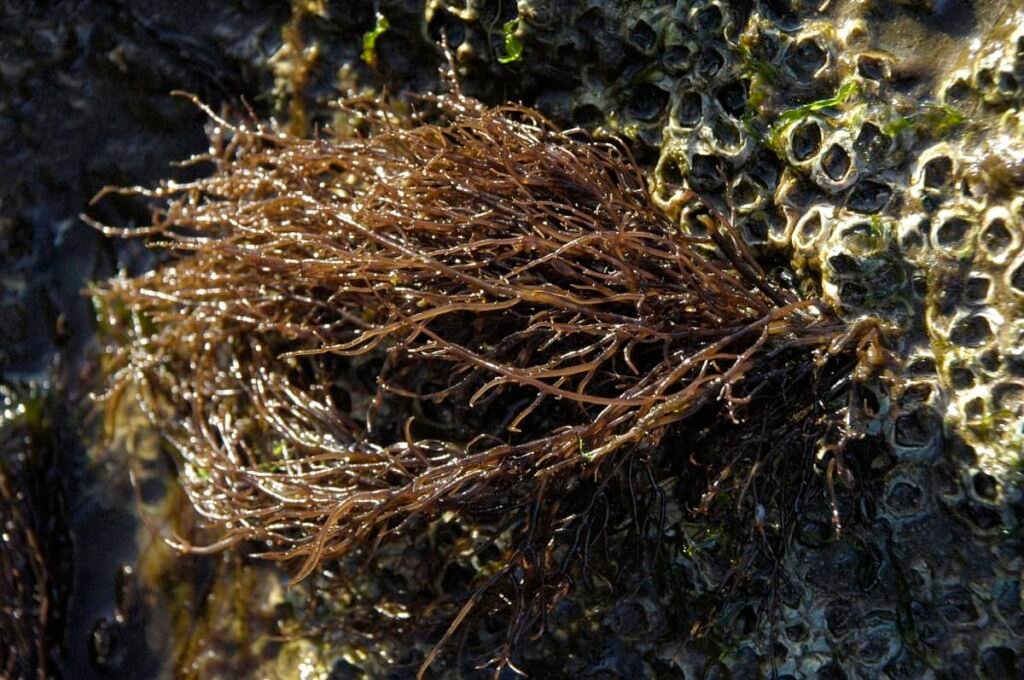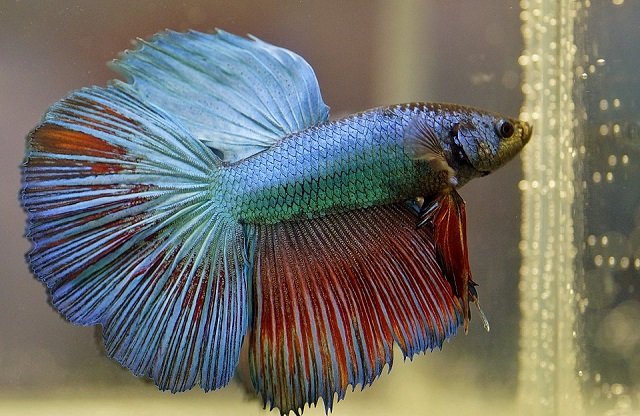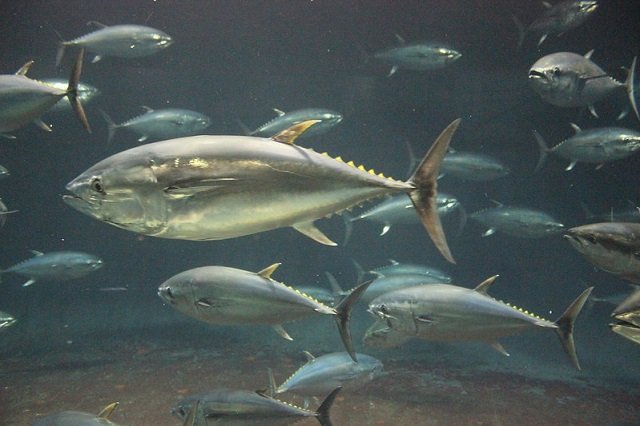
Algae of the genus Gracilaria, such as Gracilaria chilensis (known locally as “pelillo”) and Gracilaria vermiculophylla, are of great economic and ecological importance. They serve as the raw material for agar production and provide refuge for numerous marine species.
In their natural habitat, attached to rocky substrates, these algae complete their sexual life cycle and produce abundant reproductive structures. However, in cultivation centers where they are propagated vegetatively on soft bottoms, a curious phenomenon is observed: a drastic reduction in their reproductive capacity. What causes this functional “infertility” on algae farms?
New research by Chilean scientists from the Millennium Institute for Applied Research in Algae Agronomy (MASH), along with international collaborators from the GEOMAR centre in Germany, has focused on an often invisible yet fundamental factor: the microbial biofilm. The study explored the hypothesis that the community of bacteria living on the algae’s surface directly influences their fertility, and the results are surprising.
Key findings
- 1 Key findings
- 2 How was the effect of microbes studied?
- 3 A different effect for each population
- 4 A delicate balance: Growth versus fertility
- 5 What if we put the bacteria back? The complexity of restoring function
- 6 Conclusion: Towards an aquaculture that considers the holobiont
- 7 Entradas relacionadas:
- The microbial biofilm, the community of bacteria on the algae’s surface, plays a crucial role in regulating the growth and fertility of the red algae Gracilaria chilensis and Gracilaria vermiculophylla.
- In cultivated populations of G. chilensis, the experimental removal of the biofilm significantly increased the production of reproductive structures (tetrasporangia), suggesting that the biofilm under farming conditions may be inhibiting fertility.
- Conversely, in natural populations of G. chilensis and native populations of G. vermiculophylla, removing the biofilm reduced both growth and fertility, indicating a positive dependency of these algae on their native microbial communities.
- The study reveals a trade-off between growth and fertility, especially in cultivated algae. Manipulating the biofilm inverted this relationship: upon its removal, fertility increased, but growth decreased.
- Simple reinoculation of bacteria failed to restore the original growth and fertility functions, suggesting that the structure and colonization process of the biofilm are complex and essential for its effectiveness.
How was the effect of microbes studied?
To decipher the relationship between the algae and their bacteria, scientists conducted a laboratory experiment with two species: G. chilensis (comparing natural rock-dwelling populations with cultivated soft-bottom populations) and G. vermiculophylla (comparing native populations from Asia with non-native or invasive populations from Europe and the USA).
The experimental design consisted of four main treatments:
- Control: Algae with their natural biofilm intact.
- Without biofilm (WB): The biofilm was completely removed from the algae’s surface using a treatment of ultrasound, brushing, and a series of antibiotics.
- Homologous reinoculation (HR): Biofilm-free algae were reintroduced to bacteria extracted from algae of the same population type (e.g., from cultivated to cultivated).
- Heterologous reinoculation (HeR): Biofilm-free algae were introduced to bacteria from an opposite population type (e.g., from natural to cultivated).
Over 35 to 40 days, researchers measured two key parameters: the specific growth rate and the density of mature tetrasporangia, which are the structures where spores for reproduction are produced.
A different effect for each population
Gracilaria chilensis: In cultivation, biofilm appears to inhibit reproduction
The findings for G. chilensis were revealing. As expected, algae from natural populations showed a higher density of reproductive structures than those from cultivated ones. The most interesting results occurred when the biofilm was removed:
- In natural populations, removing the biofilm had no effect on fertility but significantly reduced growth. This suggests that native bacteria are important for the alga’s vegetative development.
- In cultivated populations, biofilm removal led to a substantial increase in tetrasporangia production. This result supports the hypothesis that the biofilm present on farms may be inhibiting the algae’s fertility in some way.
Gracilaria vermiculophylla: Native populations depend on their biofilm
In the case of G. vermiculophylla, the response was different, demonstrating that these interactions are species- and context-specific.
Stay Always Informed
Join our communities to instantly receive the most important news, reports, and analysis from the aquaculture industry.
- In native populations, removing the biofilm drastically reduced fertility. This indicates a clear dependence of the alga on its associated bacteria to reproduce successfully in its original environment.
- In non-native populations, no significant effect was detected upon biofilm removal.
A delicate balance: Growth versus fertility
One of the most important concepts this study reveals is the biological “trade-off” between growing and reproducing. Resources are limited, and an organism must “decide” whether to invest them in increasing its size or in generating offspring.
In cultivated populations of G. chilensis and non-native populations of G. vermiculophylla, the biofilm appears to regulate this balance. With their natural biofilm, these algae grow faster but are less fertile. When the biofilm is removed, the trend reverses: they grow less but invest more resources in reproduction. This suggests that the microbiota plays a regulatory role in how the alga allocates its energy—a phenomenon that may have been selected, consciously or unconsciously, in cultivation practices that prioritize biomass.
What if we put the bacteria back? The complexity of restoring function
If the biofilm is so important, is it enough to simply reintroduce the bacteria to restore its effects? According to this study, the answer is no.
In most cases, reinoculation (both homologous and heterologous) failed to restore the growth or fertility levels observed in the controls. This suggests that the mere presence of bacteria is not sufficient. The biofilm’s functional success likely depends on a specific community structure, an orderly colonization sequence, and complex ecological interactions among the microbes. A massive, disordered reinoculation cannot replicate the functional architecture of a mature, native biofilm.
Conclusion: Towards an aquaculture that considers the holobiont
This study convincingly demonstrates that algae should not be seen as isolated organisms but as “holobionts”: a functional unit composed of the alga (the host) and its complex community of associated microorganisms.
The research team noted that the study confirmed, “despite the characteristic low fertility of G. chilensis cultures and the clonal propagation that predominates on sandy-muddy bottoms, some specimens still retain the ability to form tetrasporangia—reproductive structures essential for maintaining the species’ genetic diversity.”
The results have profound implications for Gracilaria aquaculture. Low fertility in cultures might not only be a consequence of vegetative propagation but also of the type of microbial community fostered in that environment. Understanding and manipulating these alga-bacteria interactions opens a new frontier for optimizing not only the growth but also the health and reproductive capacity of cultivated algae.
Future research should focus on identifying which specific bacteria or bacterial consortia are responsible for these effects and how the biofilm can be managed to improve the sustainability and efficiency of algae production.
Contact
Sara Usandizaga
Millenium Nucleus MASH, Facultad de Ciencias Biológicas, Pontificia Universidad Católica de Chile
Santiago, Chile
Email: susandizaga@gmail.com
Reference
Usandizaga, S., Olivos, J. P., Beltrán, J., Weinberger, F., Guillemin, M. L., & Faugeron, S. (2025). Microbial biofilm influences tetrasporophyte fertility in clonal and sexual populations of two Gracilaria species. Journal of Applied Phycology, 1-13.
Editor at the digital magazine AquaHoy. He holds a degree in Aquaculture Biology from the National University of Santa (UNS) and a Master’s degree in Science and Innovation Management from the Polytechnic University of Valencia, with postgraduate diplomas in Business Innovation and Innovation Management. He possesses extensive experience in the aquaculture and fisheries sector, having led the Fisheries Innovation Unit of the National Program for Innovation in Fisheries and Aquaculture (PNIPA). He has served as a senior consultant in technology watch, an innovation project formulator and advisor, and a lecturer at UNS. He is a member of the Peruvian College of Biologists and was recognized by the World Aquaculture Society (WAS) in 2016 for his contribution to aquaculture.




